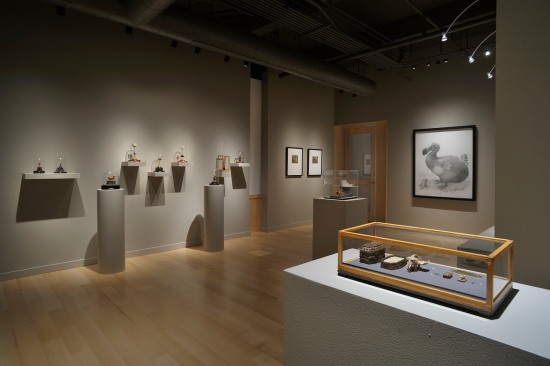
Hackett Mill is pleased to present David Beck and Robert Schwartz, in an exhibition that brings together the miniaturized worlds of sculpture and painting. Taking a unique approach with extraordinary deftness, Beck and Schwartz rely on the miniature scale of remarkable detail and an irrepressible whimsy of ideas, to ensure that all of us, whatever our distractions and limitations, can enter another world of delights that feels both familiar and remarkable, contemporary and timeless. The small-scale works of these two San Franciscan artists make profound and moving statements through a masquerade world in caricature about a bizarre humanity.
David Beck seems to draw his inspiration from the 17th century cabinets of curiosities, developing a fascinating repertoire of sculptures with moving parts, cameos with gorgeous surfaces, and public performances an opera house, a museum, and a jazz concert as the premise of his constructions. Painstakingly handcrafting every component of his elaborate sculptures himself with the use of exotic materials, boxwood, ivories, elaborate inlays and fine lacquers, it is possible to identify some of the artistic and technological traditions on which Beck builds, yet he takes great care about when to show off his methods and when to cover his tracks. Rich with overt and hidden narratives, and displaying a seamless synthesis of past and present, Beck’s complex, animated sculptures result in a sumptuous banquet to be consumed by both eye and mind.
Robert Schwartz wrote that he "[invented] a world to reveal certain truths about being human." A Chicago native, Robert Schwartz adopted San Francisco as his home soon after he arrived in 1971. Trained at the Art Institute of Chicago during the height of pop art, he was virtually self-taught in the techniques of illusory painting. Schwartz’s laborious technique and meticulous detail is often described as a 20th-century analogue to the craftsmanship and devotion evident in religious narratives of medieval illuminated manuscripts. However, unlike religious narrative, which drew upon texts familiar to all, the implied master narrative that generates Schwartz’s cityscapes and landscapes are inaccessible to the viewer, and may not exist at all. The astonishing details painted with jewel-like colors consist of incredibly complex compositions that place individuals in realistic, yet highly inventive, environments and situations that are sometimes absurd or apocalyptic. In the words of critic Donald Kuspit, “[Schwartz is] a master at narrating paradox—his works are deceptively clear, as though to disclose the intrinsic connection of opposites by bringing their disconnection into sharp focus."
David Beck received his BFA from Carnegie Mellon University and, in 1976, moved to New York City where he showed with Allan Stone Gallery. Beck’s famed public performances the MVSEVM and Movie Palace are part of the permanent collection at the Smithsonian American Art Museum. In 1989, David Beck made San Francisco his permanent residence. Robert Schwartz received a National Endowment for the Arts WESTAF Award in 1992. In 2000 Seattle’s Frye Art Museum hosted a retrospective exhibition of Schwartz's work, following a 1990 survey at the De Saisset Museum of Santa Clara, California. This is the first exhibition of Robert Schwartz since the 2004 San Jose Museum of Art’s retrospective and published monograph, "Dream Games: The Art of Robert Schwartz, " by Barry Schwabsky and Susan Landauer.
A close look at the works of Beck and Schwartz brings great rewards. Both artists demonstrate an encyclopedic visual complexity that appeals to viewing their work, as well as a sensual pleasure for our jaded times. “Those who stay,” Beck predicts, “will be rewarded.”
